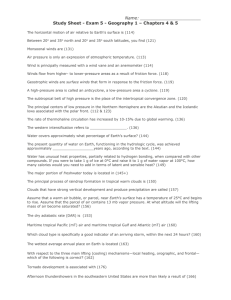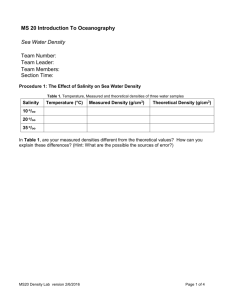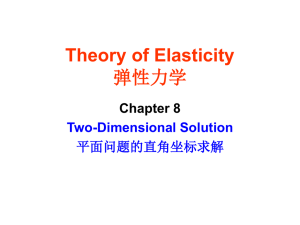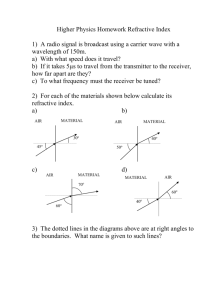Nonlinear Time Series Flood Modelling By using System
advertisement
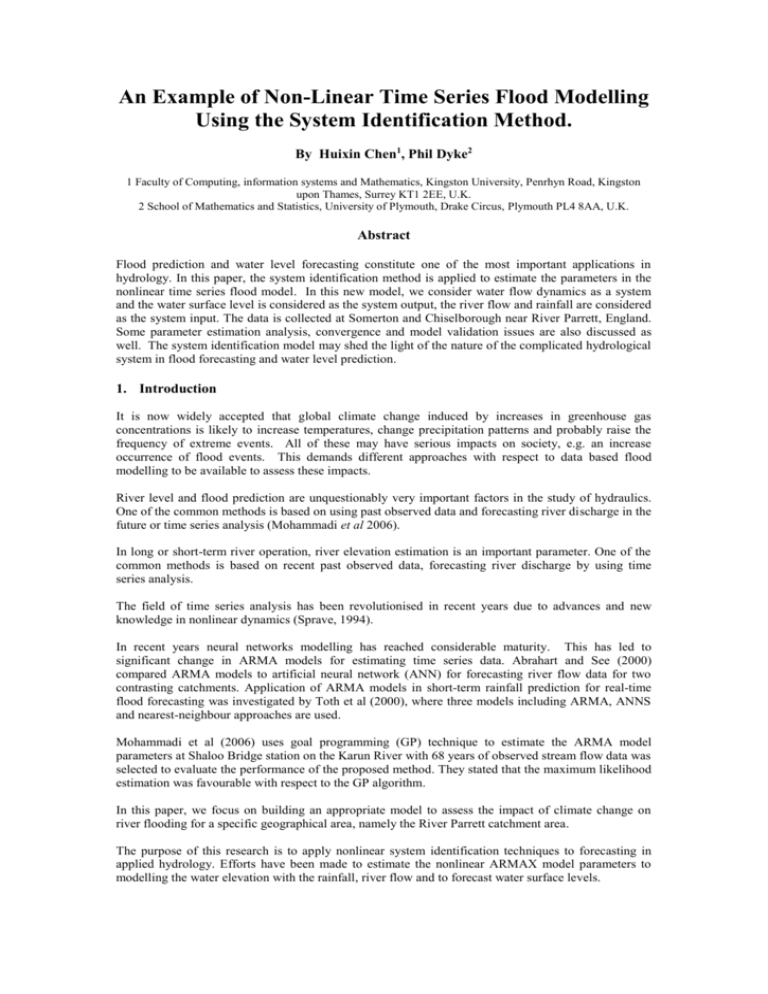
An Example of Non-Linear Time Series Flood Modelling Using the System Identification Method. By Huixin Chen1, Phil Dyke2 1 Faculty of Computing, information systems and Mathematics, Kingston University, Penrhyn Road, Kingston upon Thames, Surrey KT1 2EE, U.K. 2 School of Mathematics and Statistics, University of Plymouth, Drake Circus, Plymouth PL4 8AA, U.K. Abstract Flood prediction and water level forecasting constitute one of the most important applications in hydrology. In this paper, the system identification method is applied to estimate the parameters in the nonlinear time series flood model. In this new model, we consider water flow dynamics as a system and the water surface level is considered as the system output, the river flow and rainfall are considered as the system input. The data is collected at Somerton and Chiselborough near River Parrett, England. Some parameter estimation analysis, convergence and model validation issues are also discussed as well. The system identification model may shed the light of the nature of the complicated hydrological system in flood forecasting and water level prediction. 1. Introduction It is now widely accepted that global climate change induced by increases in greenhouse gas concentrations is likely to increase temperatures, change precipitation patterns and probably raise the frequency of extreme events. All of these may have serious impacts on society, e.g. an increase occurrence of flood events. This demands different approaches with respect to data based flood modelling to be available to assess these impacts. River level and flood prediction are unquestionably very important factors in the study of hydraulics. One of the common methods is based on using past observed data and forecasting river discharge in the future or time series analysis (Mohammadi et al 2006). In long or short-term river operation, river elevation estimation is an important parameter. One of the common methods is based on recent past observed data, forecasting river discharge by using time series analysis. The field of time series analysis has been revolutionised in recent years due to advances and new knowledge in nonlinear dynamics (Sprave, 1994). In recent years neural networks modelling has reached considerable maturity. This has led to significant change in ARMA models for estimating time series data. Abrahart and See (2000) compared ARMA models to artificial neural network (ANN) for forecasting river flow data for two contrasting catchments. Application of ARMA models in short-term rainfall prediction for real-time flood forecasting was investigated by Toth et al (2000), where three models including ARMA, ANNS and nearest-neighbour approaches are used. Mohammadi et al (2006) uses goal programming (GP) technique to estimate the ARMA model parameters at Shaloo Bridge station on the Karun River with 68 years of observed stream flow data was selected to evaluate the performance of the proposed method. They stated that the maximum likelihood estimation was favourable with respect to the GP algorithm. In this paper, we focus on building an appropriate model to assess the impact of climate change on river flooding for a specific geographical area, namely the River Parrett catchment area. The purpose of this research is to apply nonlinear system identification techniques to forecasting in applied hydrology. Efforts have been made to estimate the nonlinear ARMAX model parameters to modelling the water elevation with the rainfall, river flow and to forecast water surface levels. 2. River Parrett Climate change may be a global concern, but its effects will very much be felt at the local level. The summer floods of 1997 and the prolonged flooding of 1999/2000 proved that the Parrett catchment’s river and drainage system cannot cope in extreme weather events and the likelihood of increased stormy conditions combined with rising sea levels will make the problem of flooding much greater over the next few decades. The Parrett catchment is a large area (1690 km2), which includes not only the River Parrett itself, but also its main tributaries, the Tone, Isle, Cary and Yeo. The area also contains the major urban areas of Taunton, Bridgewater and Yeovil and the internationally significant Somerset Levels and Moors. It is economically, culturally, archaeologically, agriculturally, and environmentally significant, with numerous international, national and local designations of land use. FIGURE 1.The Parrett Catchment (http://www.somerset.gov.uk/ete/pcp/). The flow quantity and water surface level are collected from Chiselborough station and the rainfall data are collected from Somerton. All the data used in this paper are in every 15 minutes in the form of time series from January 2001 to June 2002, which is provided by Environmental Agency of the United Kingdom. 3. System Identification The phrase System Identification is the name given to the field of modelling dynamic systems from either experimental or observed data. A dynamic system can be conceptually described as shown in Figure 2. System identification using linear model structures has been extensively developed and the theories such as model order selection, consistency and optimal input selection are mature and have been summarized in (Chen and Guo, 1985; Söderström and Stoica, 1989 and Ljung, 1999). Chen and Dyke (1996, 1998); Chen et al (1999) applied the linear system identification methods to modelling sediment transportation problem in different coastal areas. Disturbance v(t) System Input u(t) Output y(t) FIGURE 2. A dynamic system with input u(t), output y(t) and disturbance v(t), where t denotes time. However, most real systems are nonlinear. In recent years, there has been much study directed at modifying the identification problem for nonlinear systems. For example, see Hu et al (2001) where a class of quasi-ARMAX models is proposed, Coca and Billings (2001) who develop a new methodology for identifying nonlinear NARMAX models and Young et al (2001) who outline how improved estimates of time variable parameters in models of stochastic dynamic systems can be obtained using recursive filtering and fixed interval smoothing (FIS) techniques, with the associated hyper-parameters optimized by maximum likelihood based in prediction error decomposition. But all the models mentioned above do not give strong consistency for their algorithms. Strong consistency is very important in mathematical modelling since we need to know if the estimated model is appropriate to the real system. We need to know if the proposed algorithm is convergent and even given this convergence, does it converge to the real parameters of the model? Chen (2004) discussed the strong consistency and convergence rate for a class of stochastic nonlinear systems. The algorithm proposed there can achieve the strong consistency of the parameter estimates under quite general restrictions on the system. 4. Model descriptions The class of nonlinear stochastic Systems we discuss here is given by: A( z ) yt B( z ) ft C ( z )wt , t 1, 2,3,... (1) where z is the unit backshift operator, A( z ), B ( z ) and C ( z ) are polynomials defined as follows: A( z ) I n A1 ( z ) ... An y z n ; y B ( z ) B1 ( z ) ... Bn f z n ; f C ( z ) I n C1 ( z ) ... Cnw z n ; w (2) yt , ut and wt are the n dimensional output vectors, m dimensional input vectors and n dimensional noise vectors of the system respectively and yt wt ut 0, t 0; f t is a m f -dimensional known bounded function of the system input, output with noises, i.e., f t f (ut ,..., ut q , yt ,..., yt p ). where p and q are integers; I n is an n n unit matrix, Ai , B j , and Ck are n n, n m f and n n matrix respectively, i 1,..., n y , j 1,..., n f and k 1,..., nw; By introducing the following notation: [ A1 , A2 ,..., An , B1 , B2 ,..., Bn , C1 , C2 ,..., Cn ]T ; y f [ y , y ,..., y 0 t T t T t 1 T t ny T T t 1 , ft , f ,..., f w T t n f T t , w , wtT1 ,..., ytTnw ]; the system (1) could be written as follows: yt T t0 t (3) 5. Extended Recursive Least Squares (ERLS) Algorithms The so called ERLS Algorithm proposed in Chen (2004) is given as follows: K n Rn 1n /(1 nT Rn 1n ) Rn Rn 1 K nnT Rn 1 n n 1 K n ( ynT nT n 1 ) en yn nT n (4) where t [ ytT , ytT1 ,..., ytTn , ftT , ftT1 ,..., ftTn , etT , etT1 ,..., etTn ]; y f w THEOREM 1: For the system (1) or (3) and algorithm ERLS (4), under the conditions of A1-A7, the estimated parameters have strong consistency to their true values. (Chen, 2004). In this paper, we select 5 models as follows to the simulations and the details of the model candidates are given as follows: Model 1 Linear Model yn 1 a1 yn a2 yn 1 b11u1,n b12u2,n b21u1,n 1 b22u2,n 1 wn 1 c1wn (5) Model 2 Bilinear Model yn1 a1 yn a2 yn 1 b11u1,n b12u2,n b21u1,n 1 b22u2, n 1 +d1,1u1, n yn d1,2u2, n yn d1,3u1, nu2, n +d2,1u1,n1 yn1 d2,2u2, n1 yn1 d2,3u1, n1u2, n1 wn1 c1wn (6) Model 3 Quadratic Model yn 1 a1 yn a2 yn 1 b11u1, n b12u2, n b21u1, n 1 b22u2, n 1 +d1,1u1, n yn d1,2u2, n yn d1,3u1, nu2, n e1,1u1,2 n e1,2u2,2 n e1,3 yn2 +d 2,1u1, n 1 yn 1 d 2,2u2, n 1 yn 1 d 2,3u1, n 1u2, n 1 e2,1u1,2 n 1 e2,2u2,2 n 1 e2,3 yn21 wn 1 c1wn (7) Model 4. Third Order Model yn 1 a1 yn a2 yn 1 b11u1, n b12u2, n b21u1, n 1 b22u2, n 1 +d1,1u1, n yn d1,2 u2, n yn d1,3u1, nu2, n e1,1u1,2 n e1,2u2,2 n e1,3 yn2 +d 2,1u1, n 1 yn 1 d 2,2 u2, n 1 yn 1 d 2,3u1, n 1u2, n 1 e2,1u1,2 n 1 e2,2u2,2 n 1 e2,3 yn21 +f1,1u1,2 n yn f1,2 u1,2 n u2, n f1,3u2,2 n yn f1,4 u2,2 n u1, n 3 3 2 2 f1,5 yn2u1, n f1,6 yn2u2, n g1,1u1,3 n g1,2 u2, n g1,3 y n +f 2,1u1, n 1 y n 1 f 2,2 u1, n 1u2, n 1 f 2,3u2,2 n 1 yn 1 f 2,4 u2,2 n 1u1, n 1 f 2,5 yn21u1, n 1 f 2,6 yn21u2, n 1 3 3 g 2,1u1,3 n 1 g 2,2u2, n 1 g 2,3 yn 1 wn 1 c1 wn (8) Model 5. Fourth Order Model yn 1 a1 yn a2 yn 1 b11u1, n b12u2, n b21u1, n 1 b22u2, n 1 +d1,1u1, n yn d1,2u2, n yn d1,3u1, nu2, n e1,1u1,2n e1,2 u2,2 n e1,3 yn2 +d 2,1u1, n 1 yn 1 d 2,2u2, n 1 yn 1 d 2,3u1, n 1u2, n 1 e2,1u1,2n 1 e2,2 u2,2 n 1 e2,3 yn21 +f1,1u1,2 n yn f1,2u1,2 nu2, n f1,3u2,2 n yn f1,4u2,2 nu1, n f1,5 yn2u1, n f1,6 yn2u2, n g1,1u1,3 n g1,2u 2,3 n g1,3 yn3 +f 2,1u1,2 n 1 yn 1 f 2,2u1,2 n 1u2, n 1 f 2,3u2,2 n 1 yn 1 f 2,4 u2,2 n 1u1, n 1 f 2,5 yn21u1, n 1 f 2,6 yn21u2, n 1 g 2,1u1,3 n 1 g 2,2u2,3 n 1 g 2,3 yn31 h1,1u1,3 n yn h1,2 u1,3 nu2, n h1,3u2,3 n yn h1,4 u2,3 nu1, n h1,5 yn3u1,n h1,6 yn3u2, n k1,1u1,2 nu2,2 n k1,2u1,2 n yn2 k1,3u2,2 n yn2 l1,1u1,4 n l1,2u2,4 n l1,3 yn4 + h2,1u1,3 n 1 yn 1 h2,2u1,3 n 1u2, n 1 h2,3u2,3 n 1 yn 1 h2,4u2,3 n 1u1, n 1 h2,5 yn31u1, n 1 h2,6 yn31u 2,n 1 k2,1u1,2 n 1u2,2 n 1 k2,2u1,2 n 1 yn21 k2,3u2,2 n 1 yn21 l2,1u1,4 n 1 l2,2u2,4 n 1 l2,3 yn41 wn 1 c1wn (9) where yn is the water surfact level (m) u1, n is the flow quantity (m3 / s ) u2, n is the Rainfall (mm) The reason we select these 5 model structures is that we can consider the unknown model structure as being yn+1=f(yn,un) approximated by the 5 model structures each with different order of Taylor series and time delay factor as. Also we present the models in terms of different time periods, that is spring, summer, autumn, winter and annual. In order to discuss the model prediction error and consistency of parameter estimation, several variables are introduced as follows: The average norm of the standard deviation of parameter estimation is defined as: 1 || std (ˆ) || (ˆ--estimated parameter vector) h The maximum of the standard deviation of parameter estimation is defined as Max || std (ˆi ) || 1 i h The average one-step prediction error is defined as: 1 N N ||yˆ i yi ||2 (yˆ i iT ˆi ) i=1 6. Simulation Results The simulation results in different order approximations and time periods are presented in the following Table 1. From the Table 1, we deduce that the summer season model is the best fitted model among the five time periods and the winter model has the worst performance. This may imply that the heavy rainfalls and floods in these seasons make it difficult to find a recognisable pattern in the time series. (Mohammadadi et al 2006). But from the Table 1, we can see all the models improve as the order increase which is quite encouraging information for the model and algorithms we have applied here. Due to the page limit of the paper, we are not going to discuss optimizing the time delay order as discussed in Söderström and Stoica (1989) in the linear system case. We will investigate the model order selection and function’s approximation in a series of future papers. From the Table 1, according to the parsimony principle (Söderström and Stoica (1989)), we take the fourth order summer season model as our best model and do the further discussions in details. When the parameter estimation is carried out, it turns out both of the mean and standard deviation of lots of the parameters equal to zero. Incorporating this into the model leads to considerable simplification of the complicated expression given by equation (9). Linear 1 || std (ˆ) || h Max || std (ˆi ) || Spring (Feb-Apr 2001) 0.0034 Summer (May-Jul 2001) 0.0018 Autumn (Aug-Oct 2001) 0.0029 Winter (Nov-Jan 2002) 0.0027 One Year (Jan-Dec, 2001) 0.0011 0.0215 0.0113 0.0180 0.0154 0.0064 2.58e-5 1.06e-5 1.69e-5 7.34e-5 3.15e-5 0.0018 9.86e-4 0.0015 0.0015 6.23e-4 0.0215 0.0111 0.0180 0.0154 0.0064 2.56e-5 1.06e-5 1.69e-5 7.30e-5 2.99e-5 0.0013 6.75e-4 0.0011 0.0010 4.45e-4 0.0215 0.0111 0.0180 0.0156 0.0069 2.55e-5 1.07e-5 1.69e-5 7.19e-5 2.82e-5 5.36e-4 5.44e-4 2.64e-4 1i h 1 N Bilinear N ||yˆ y || 2 i i i=1 1 || std (ˆ) || h Max || std (ˆi ) || 1i h 1 N Second Order N ||yˆi yi ||2 i=1 1 || std (ˆ) || h Max || std (ˆ ) || i 1i h 1 N Third Order N ||yˆ y || 2 i i i=1 6.30e-4 1 || std (ˆ) || h Max || std (ˆi ) || 3.48e-4 0.0215 0.0113 0.0180 0.0165 0.0085 2.49e-5 1.05e-5 1.66e-5 6.64e-5 2.23e-5 3.73e-4 2.11e-4 3.22e-04 3.80e-4 1.94e-4 0.0215 0.0112 0.0181 0.0205 0.0100 2.39e-5 1.04e-5 1.61e-5 3.93e-5 3.72e-5 1i h 1 N Fourth Order N ||yˆi yi ||2 i=1 1 || std (ˆ) || h Max || std (ˆ ) || i 1i h 1 N N ||yˆ y || 2 i i i=1 TABLE 1. The comparisons of different model structures After parameter estimation, the fourth order summer season model can in fact be written much more succinctly in the form of the model as follows: Simplified Model yn 1 a1 yn a2 yn 1 b11u1,n b21u1, n 1 +d1,1u1, n yn e11u1,2n e12u2,2 n e1,3 yn2 +d 2,1u1, n 1 yn 1 e2,1u1,2n 1 e2,2u2,2 n 1 e23 yn21 +f1,1u1,2 n yn g1,1u1,3 n +f 2,1u1,2n 1 yn 1 g2,1u1,3 n 1 h1,1u1,3 n yn h1,5 yn3u1,n k1,2u1,2n yn2 l1,1u1,4n + h2,1u1,3 n 1 yn 1 h2,5 yn31u1, n 1 k2,2u1,2n 1 yn21 l2,1u1,4n 1 wn 1 c1wn FIGURE 3. The comparison of the data with model predictions FIGURE 4. The parameters of model (10) with time Figure 3 shows the comparison of the data with the one-step model predictions for both of the Models (9) and (10). The red line is the water surface data from May 1 st, 2001 to August 31st, 2001 (15minute (10) per sample). The blue line is the one-step model prediction error for the simplified model (10) and the black line is the one-step model prediction error for the fourth order model (10) with a shift downwards of 0.1 unit. The water surface elevation is metres. Figure 4. shows the estimated parameters in the Simplified Model (10) with time. From the Figure 4, we can make the conclusion that all the estimated parameters can be considered to be constants with the time which imply the parameters we identified by using ERLS algorithm (4) have strong consistency with the model structure (10). Therefore the Simplified Model (10) could be a very good water surface level model at River Parrett for the summer season based on the data collected. From the parameter estimation of model (10), it is found that the modulus of parameters a1 , a2 , b11 , c1 , d11 , d21 , f11 , k12 , k22 are significantly greater than 0.02 and the others can be considered very close to zero (to 2 decimal places) which implies that the water surface level 2 2 2 yn1 are strongly 2 relevant to the items yn , yn 1 , u1, n , wn , u1,n yn , u1,n 1 yn 1 , u1,n yn , u1,n 1 yn 1 .The affects from the rainfall data are not very significant in the summer season which will need further investigation. 7. Model evaluation and interpretation From the simulation results given by Figures 3-4, it is shown the models we give are a very good approximation to the real data. Since there are no big differences in terms of model prediction errors between models (9) and (10) in the summer season one, considering the calculation cost, we suggest the simplified model (10) would be more appropriate. From the parameter estimated given by Figure 4, it is shown the strong consistence of the parameter estimation as well for the model (10). According to Theorem 1, we can conclude that the model structure given by this paper is appropriate to the data based modelling and the model parameters estimation performance is very good too which is very encouraging for further investigation on flood modelling issues. 8. Comments and Conclusion The models we presented here are purely data based ones. The parameters estimated in the model can vary according to the time, location and geographic characteristics. The main advantages of our models and algorithms can be summarized as follows: 1. Very flexible model structures can make it feasible approximation of the real model 2. The requirement of the strong consistency and quick convergence rate is quite standard 3. It is an on-line model and can be implemented into other hydraulic models if it is necessary. 4. Adaptive on-line modelling and predictions which can make the automatic monitoring and warning system possible. Future work is as follows: 1. Further investigation of the key model relevant variables and to do further data collections accordingly. 2. Collect more data to verify the model physical and hydraulic meaning of estimated parameters and better interpretation of the model in terms of hydraulics. 3. Further investigation on descriptions on the physical, mathematical process and data based modelling issues in terns of the temporal and spatial scales. (Booij, 2002). 9. Acknowledgement The authors are very grateful to the Environmental Agency of the United Kingdom for unrestricted access to environmental data on the River Parrett that enabled this research to take place. 10. References ABRAHART, R.J., SEE,L., 2000. Comparing neural network and autoregressive moving average techniques for the provision of continuous river flow forecasts in two contrasting catchments. Journal of hydralogical Processes. 14, 2157-2172. BOOIJ, M.J., 2002. Appropriate Hydrological Modelling of Climate Change Impacts on River Flooding. IEMSS, 24-27, June 2002, Lugano, Switzerland CHEN, H.F., AND GUO, L, 1985, Convergence rate of least-squares identification and adaptive control for stochastic systems. Int.J.Control, 34, 921936. CHEN,H. AND DYKE, P.P.G., 1996. Multivariable Time Series Sediment Dynamic Model and Its Identification In Refiji Delta,Tanzania. Applied Mathematical Modelling Vol.20, October, pp.756--770. CHEN,H., DYKE, P.P.G. 1998. Multivariate Time Series Model For Suspended Sediment Concentration. Continental Shelf Research Vol 18, pp. 123-150. (UK ISSN 0278-4343) 2263, 2741 CHEN,H., DYKE, P.P.G. BLEWETT, J., AND HUNTLEY, D. 1999. Time Series Simulation of Suspended Sediment Concentration Observations on the Holderness Coast. SAMS, 1999, Vol. 36, pp. 271-303. CHEN, H. 2004. Extended Least Square Algorithm for Nonlinear Stochastic Systems. ACC2004, Boston. June 30-July 2, pp. 4758-4763. COCA, D. AND BILLING, S.A., 2001. Nonlinear System Identification Using Waveletand Multiresolution Models. Int. J. Control, Vol 74, No.18, 17181736. HU, J., KUMAMARU, K. AND HIRASAWA,K.,2001. A Quasi-ARMAX approach to modelling of nonlinear systems. Int. J. Control, Vol 74, No.18, 1754-1766. LJUNG, L., 1999. System Identification: Theory for the User, 2nd edition. (Upper Saddle River, NJ: Prentice Hall) MOHAMMADI, K., ESLAMI, H.R., AND KAHAWITA, R. 2006. Parameter estimation of an ARMA model for river flow forecasting using goal programming, Journal of Hydrology, Vol. 331, pp. 293-299. SÖDERSTRÖM, T., AND STOICA, P., 1989. System Identification (Upper Saddle River, NJ: Prentice Hall) SPRAVE, J., 1994. Linear neighbourhood evolution strategy. In: Proceedings of the 3rd Annual Conference on Evolutionary Programming> World Scientific, Singapore, pp.42-51. TOTH, E., BRATH, A., MONTANARI, A., 2000. Comparison of short-term rainfall prediction models for real-time flood forecasting. Journal of Hydrology 239, 132-147. YOUNG, P.C., MCKENNA, P. AND BRUUN, J., 2001. Identification of nonlinear stochastic system by state dependent parameter estimation. Int. J. Control, Vol 74, No.18, 1837-1857.



